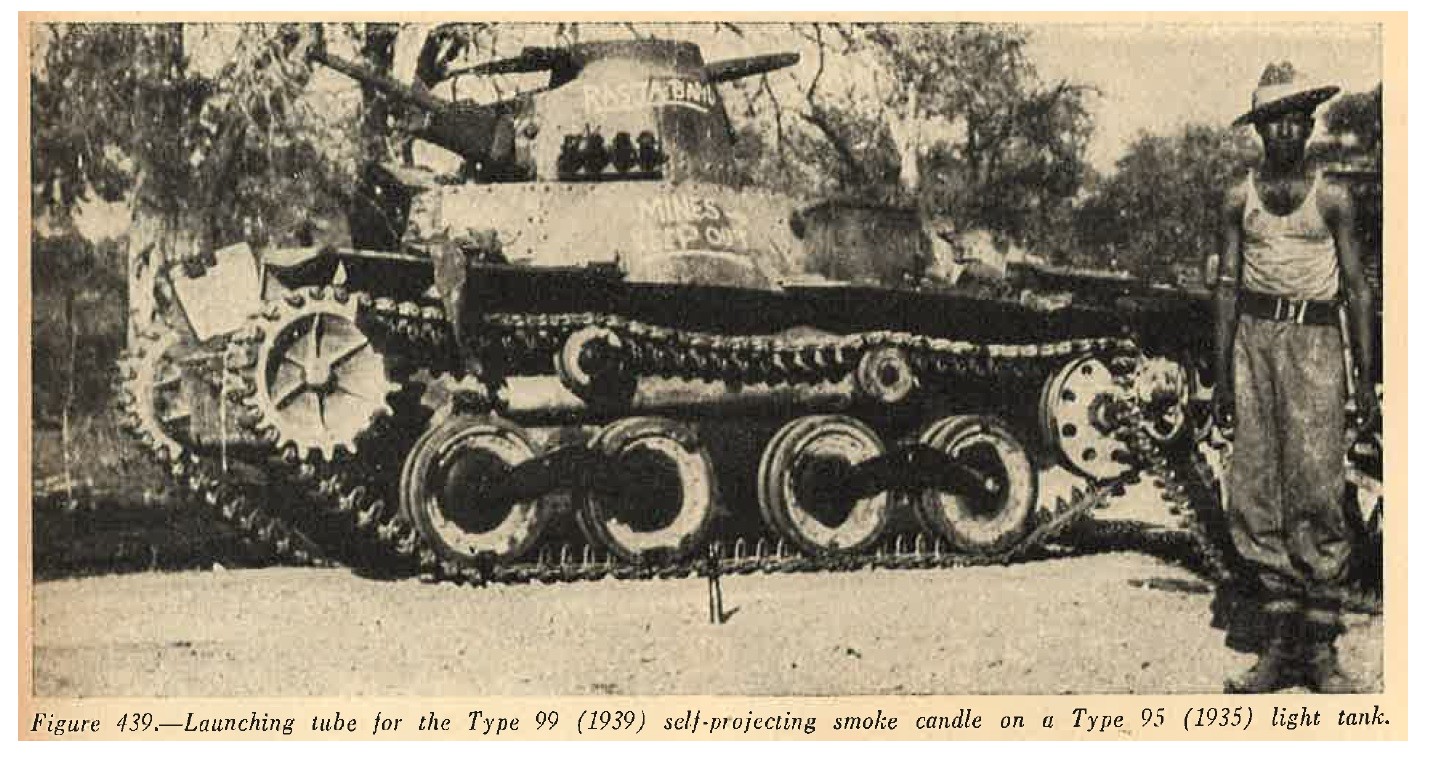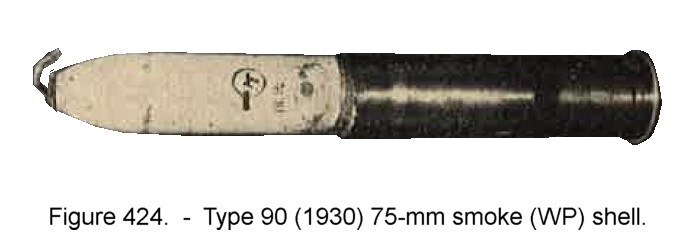CHAPTER - 9C2, 9D2 EQUIPMENT

4. WWII JAPANESE GAS GRANADES
a. Frangile Hydrocyanic acid HCN grenades.
(1) General. Two types of this grenade have been recovered (as of 1944). Both grenades consist of a spherical glass flask, with a short neck sealed with a rubber or cork stopper and crown cap, and filled with hydrocyanic acid plus a stabilizing agent.
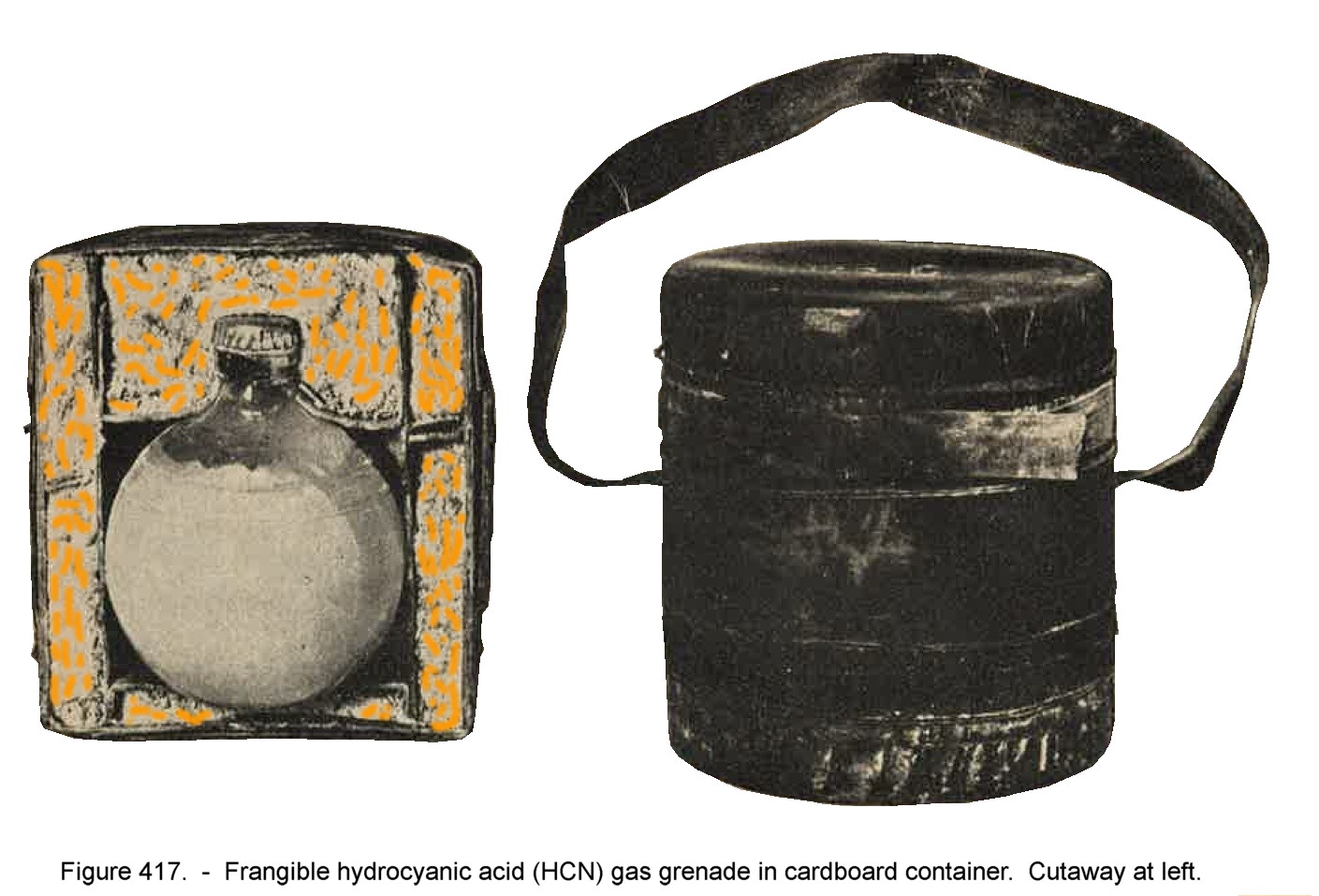
One of these grenades is packed in a cylindrical metal container, fitted with a wire handle on top and two wire handles on the side. The other grenade is packed in a cylindrical cardboard container, fitted with a web carrying strap. Both types of containers are painted olive-drab and have a cylindrical inner pocket which holds the grenade, around which is packed sawdust and a neutralizing agent of soda ash.
(2) Frangile HCN grenade (in metal container) The hydrocyanic-acid filling of this grenade contains a stabilizing agent of copper powder.
Characteristics;
|
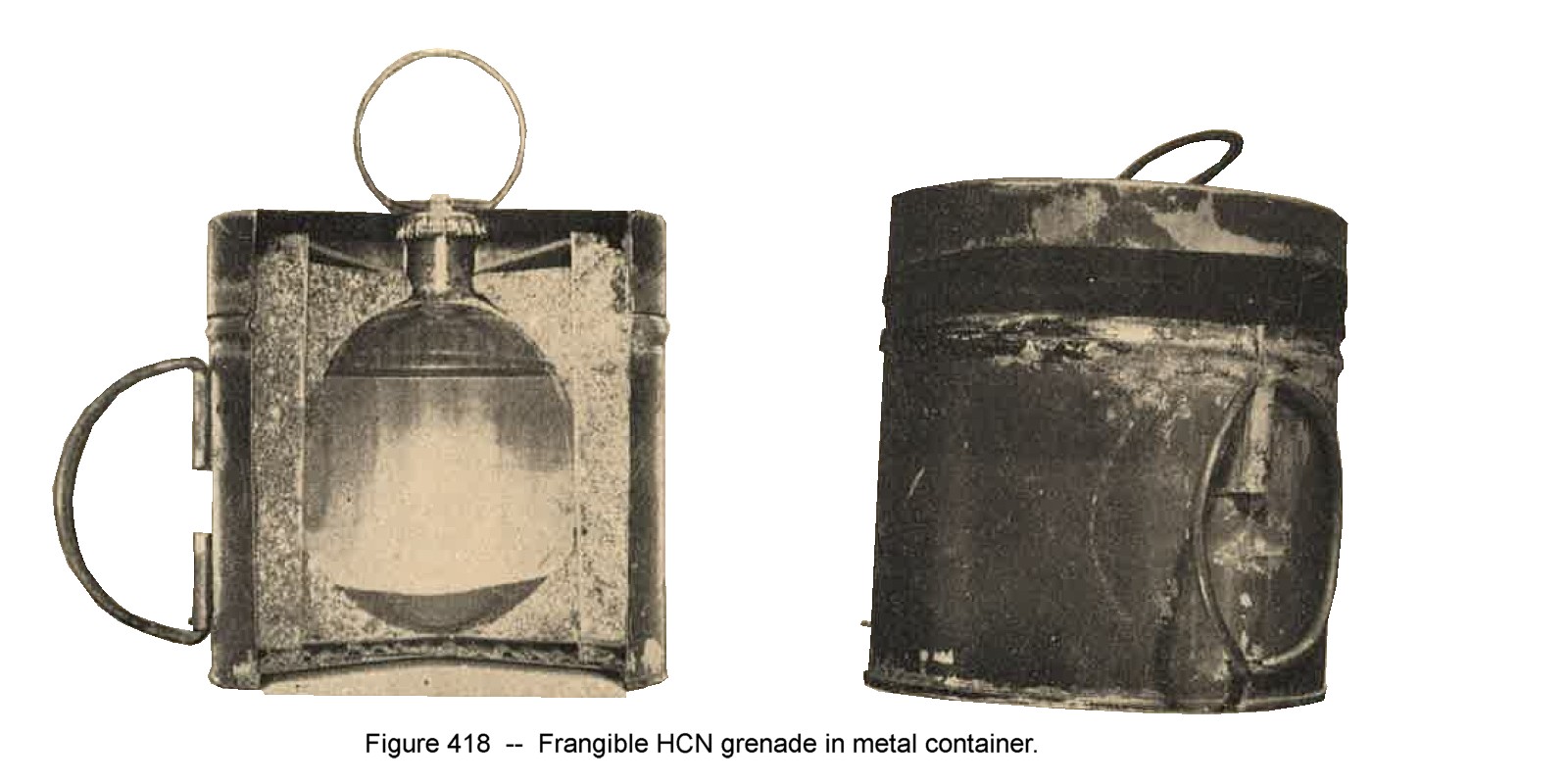
(3) Frangile HCN grenade (in cardboard container) The hydrocyanic acid filling of this grenade contains a stabilizing agent of arsenic trioxide.
Characteristics:
|
b. Type 92 (1932) tear-gas (Green) grenade.
To date (1944), no speciment of this grenade has been recovered. Indications are that by addition of a propellent container similar to that used with the Type 91 (1931) HE grenade it may be fired from both the Type 10 (1921) and Type 89 (1929) grenade dischargers. In addition it may be thrown by hand.
Characteristics:
| 1. | Weight of chemical filling | --------- | 1.3 ounces. |
| 2. | Nature of bursting charge | --------- | TNT. |
| 3. | Weight of bursting charge | --------- | 1.06 ounces. |
| 4. | Type of fuze | --------- | Type 10 (1921) |
c. Type 92 (1932) vomiting-gas grenade.
No speciment of this grenade has been recovered to date. Indications are that it may be thrown by hane or, by addition of propellent container, fired from the Type 10 (1921) and Type 89 (1929) grenade dischargers.
Characteristics:
| 1. | Nature of chemical filling | --------- | Diphenylcyanarsine ("Red Mark I"). |
| 2. | Weight of chemical filling | --------- | 1,4 ounces. |
| 3. | Nature of bursting charge | --------- | TNT |
| 4. | Weight of bursting charge | --------- | 1.06 ounces. |
| 5. | Type of fuze | --------- | Type 10 (1921). |
5. WWII JAPANESE GAS CANDLES
Most Japanese gas and smoke candles of the stationary and hand-thrown type are fired by matchhead fuze and scratcher block. All Japanese self projecting gas and smoke candles are provided with an outer container equipped with a sliding metal spike. Before firing the candle, this spike is driven into the ground to maintain the candle at the desired angle.
A matchhead at the lower end of the candle is then ignited with a scratcher block and sets off the propellent charge, which expels the inner container (projectile) carrying the main charge. The main charge is then set off by a delay fuze ignited by the flash of the propellent charge. Japanese self-projecting smoke candles can also be fired from specially designed multi-barrel launchers. The candles are set off wither manually by using a scratcher block, or electrically by means of a small heating coil fitted over teh matchhead.
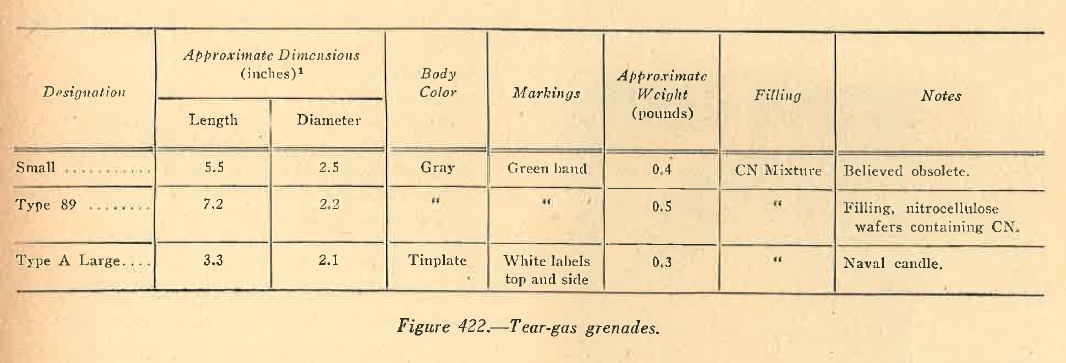
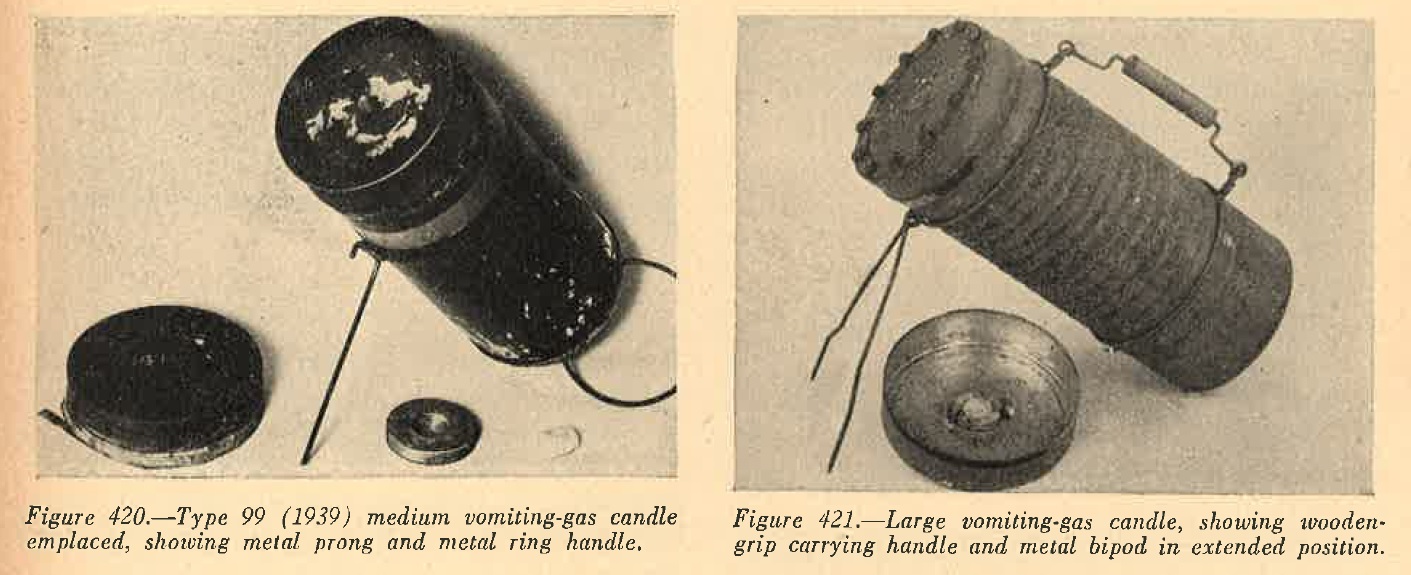
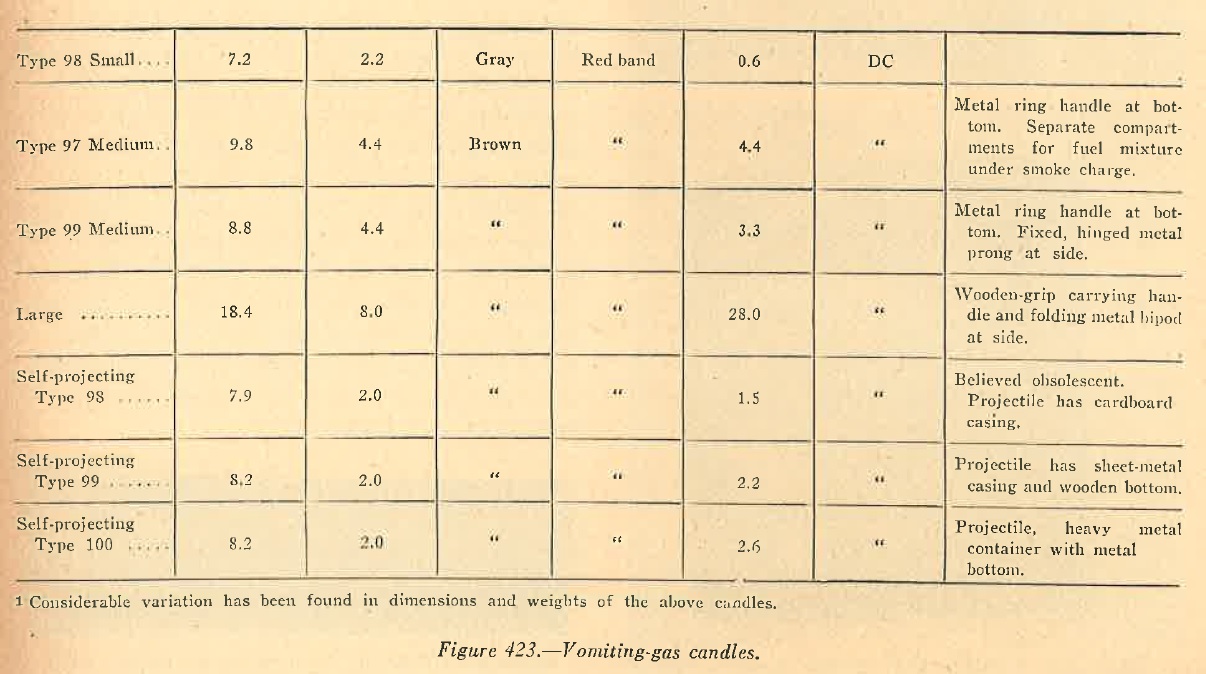
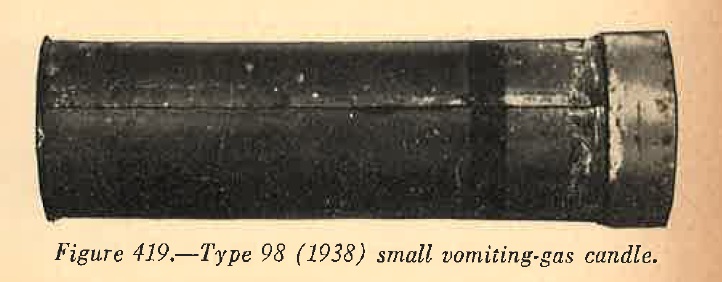
6. WWII JAPANESE SMOKE BOMBS
a. One kilogram (2.2 pound) smole-antipersonnel bomb.
This bomb is used as a marker in conjunction with demolition bombs. On explosion, antipersonnel effect is achieved by fragmentation of the cast iron body.
Characteristics.
| 1. | Overall length | --------- | 10.5 inches. |
| 2. | Body diameter | --------- | 3 inches. |
| 3. | Filling | --------- | Picric acid burster and red phosphorus smoke charge. |
| 4. | Markings | --------- | White rubber nose, black body, white tail cone and fins. |
b. 50-kilogram (110 pound) smoke bomb.
Characteristics.
| 1. | Overall length | --------- | 40 inches. |
| 2. | Body diameter | --------- | 7 inches. |
| 3. | Filling | --------- | 50.6 pounds of sulfur trioxide chlorsulfonic acid (FS smoke) |
| 4. | Color and markings | --------- | Gray body and tail; red band around nose. Smoke symbol "KE". |
7. WWII JAPANESE SMOKE SHELLS
a. Type 95 (1935) 50-mm smoke shell.
This shell is fitted with a copper rotating band and, except for a time fuze, closely resembles the Type 89 (1929) HE shell in external appearance. The Type 95 (1935) smoke shell can be fired from the Type 89 (1929) 50-mm grenade discharger only.
Characteristics:
| 1. | Weight, fuzed | --------- | Approximately 2.4 pounds. |
| 2. | Length fuzed | --------- | Approximately 5.7 inches. |
| 3. | Length, withuot fuze | --------- | Approximately 4.3 inches. |
| 4. | Maximum diameter | --------- | 1.97 inches. |
| 5. | Body material | --------- | Steel. |
| 6. | Nature of smoke filling | --------- |
Hexachlorethane : 45 % Zinc: 17% Zinc oxide: 35.5% Zinc chloride 3.6 % |
| 7. | Weight of smoke filling | --------- | 3.53.ounces. |
| 8. | Type of fuze | --------- | Type 89 (1929) small, time. |
| 9. | Duration | --------- | 1 minute. |
| 10. | Screening effect | --------- | Five rounds cover a front of 55 yards. |
| 11. | Minimum range | --------- | 110 yards. |
| 12. | Maximum range | --------- | 436 uyards. |
| 13. | Color markings | --------- |
Black body; Red band below fuze; White band around body above rotating band; White band below bourrelet |
b. Type 11 (1922) 70-mm smoke shell.
This projectile is fired from the Type 11 (1922) 70-mm mortar, and although no specimen has been recovered, it is assumed that the body length of the projectile (unfuzed) would approximate that of the HE shell (7.1 inches). In addition, it is probable that the body would be painted black with a red band immediately below teh fuze and two white bands around the body.
Characteristics:
| 1. | Weight, fuzed | --------- | 6.1 pounds. |
| 2. | Nature of smoke filling | --------- | White phosphorus. |
| 3. | Weight of smoke filling | --------- | 15.2 ounces. |
| 4. | Type of fuze | --------- | Type 88 (1928) small instantaneous. |
c. Type 90 (1930) 75-mm smoke shell.
This projectiile has a steel body and, when fitted to teh suitable carriage case, may be fired from any of the Japanese 75-mm field guns.
d. 90-mm smoke shells.
Two models, the Type 97 (1937) and Type 94 (1934) experimental model, have been identified. Available evidence indicates that they are similar, and it is assumed that the Type 97 (1937) is the production designation of the experimental Type 94 (1934) sheel. Both shells are fitted with the Type 5 (1916) combination (time and impact) fuze, and contain six canisters of smoke composition, which in the case of the Type 94 shell have a total weight of 2.64 pounds. It would appear that the object of the time fuze is to secure an air burst, thus scattering the canisters over a wide area. Both shells may be fired from the Type 94 (1934) and Type 97 (1937) 90-mm mortars.
e. Type 14 (1925) 105-mm smoke shell.
This shell has not been recovered (as of 1944), but it is thought to be fired from the Type 14 (1925) and Type 38 (1905) field guns. The projectile, fitted with Type 5 (1916) combination (time and impact) fuze, weighs 35.6 pounds, and contains 5.7 pounds of White Phosphorus.
f. Type 13 (1924) 150-mm smoke shell.
This projectile may be fired from the Type 38 (1905) and the Type 4 (1915) 150-mm howitzers.
Characteristics:
|
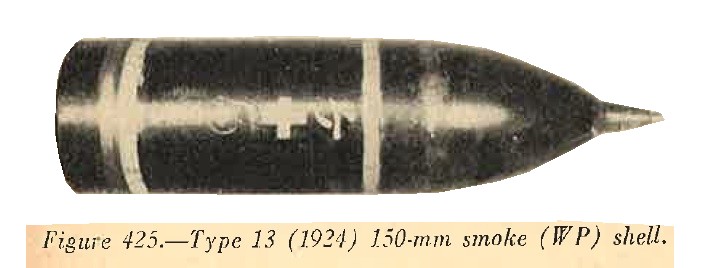 |
8. WWII JAPANESE SMOKE GRENADES
a. Type 11 (1922) 50-mm smoke grenade.
This is a hand grenade which, by the addition of a propellent container screwed to the base, may be fired from both the Type 10 (1921) and Type 89 (1929) 50-mm grenade dischargers. The fuze, propellent container, and methods of firing are similar to Type 10 (1921) HE grenades. No data are available concerning the screening effect of this grenade, but it is assumed that it would have approximately the same range as Type 91 (1931) HE grenade.
Characteristics:
|
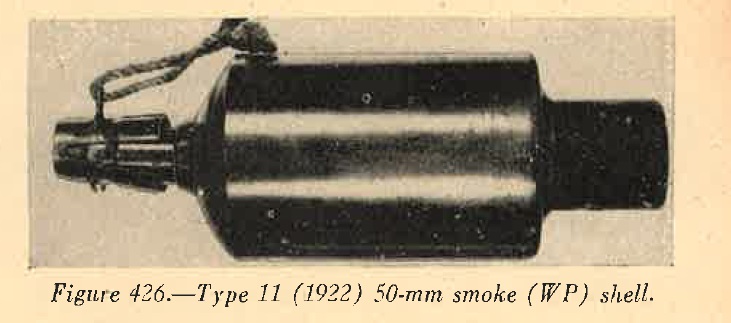 |
b. Rifle smoke grenade (HC type).
This fuzeless rifle grenade consists of a light, metal body containing a smoke mixture, a finned tail piece, and a removable rounded nose cap. The grenade is fired from the same spigot launcher as the Type 91 (1931) HE grenade, and uses the same type of blank cartridge with wooden bullet. On firing, the flash of the propellent initiates an igniter pellet in the base of the grenade body, which in turn ignites the smoke mixture.
The heat generated opens four ports in the base of the grenade body, through which the smoke escapes. The blank cartridge is normally contained in the tailpiece which is sealed by adhesive tape and paraffin. A length of cord is attached to the blank cartridge for ease of removal.
Characteristics:
|
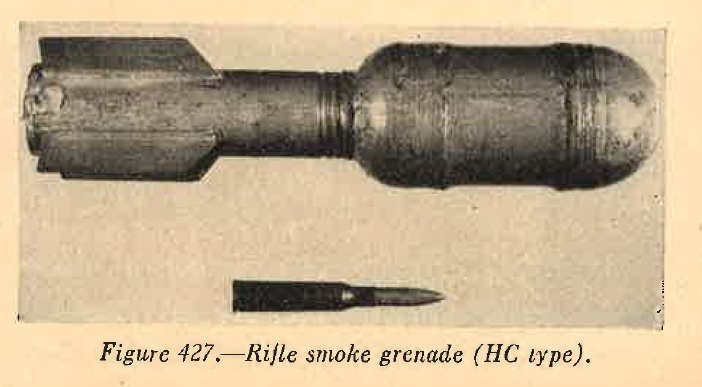 |
c. Rifle smoke grenade (WP).
This grenade consists of a White Phosphorus filled steel body and a finned tailpiece. The addition of a nose fuze and a 0.5 inch purple band around the body distinguishes it from the HE type rifle grenade. The delay nose fuze is initiated by setback. The grenade uses the same spigot launcher as the Type 3 (1943) HE grenade and is fired by means of a similar blank cartridge from both the 6.5-mm and 7.7-mm rifles.
Characteristics:
|
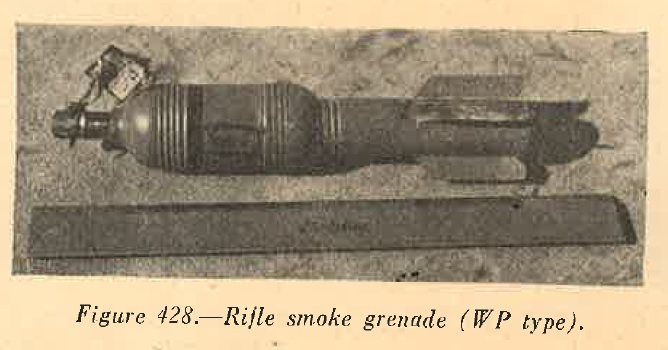 |
d. Frangible smoke grenade.
This grenade cosists of a spherical glass flask with a flat bottom and short neck. The flask is sealed with a rubber stopper retained by a double crown cap. The smoke filling is a yellowish liquid, varying from 100 percent titanium tetrachloride to a mixture of approximately 60 percent titanium tetrachloride and 40 percent silicon tetrachloride. Prior to use, the grenade is cushioned in sawdust and packed in cylindrical sheet metal container. The glass flask is broken on impact, causing the smoke reaction.
Characteristics:
|
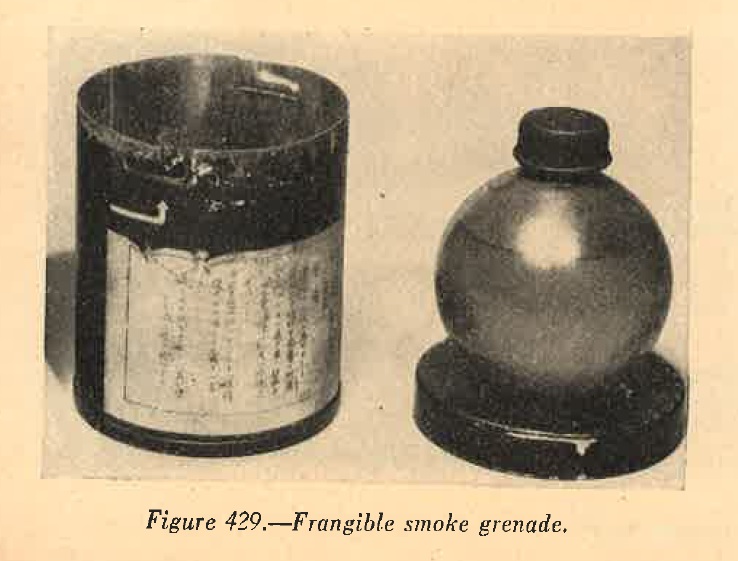 |
9. WWII JAPANESE SMOKE CANDLES
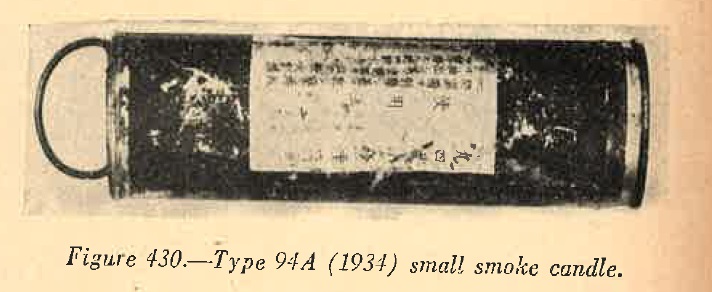 |
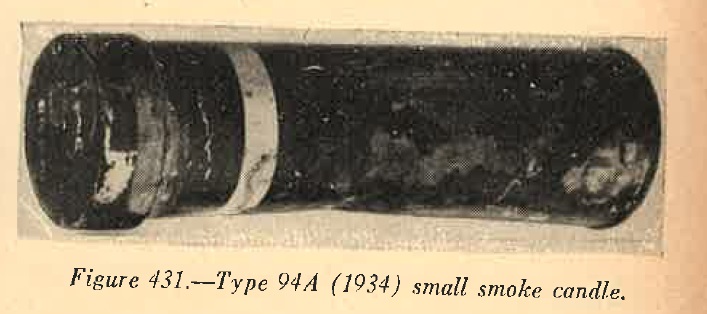 |
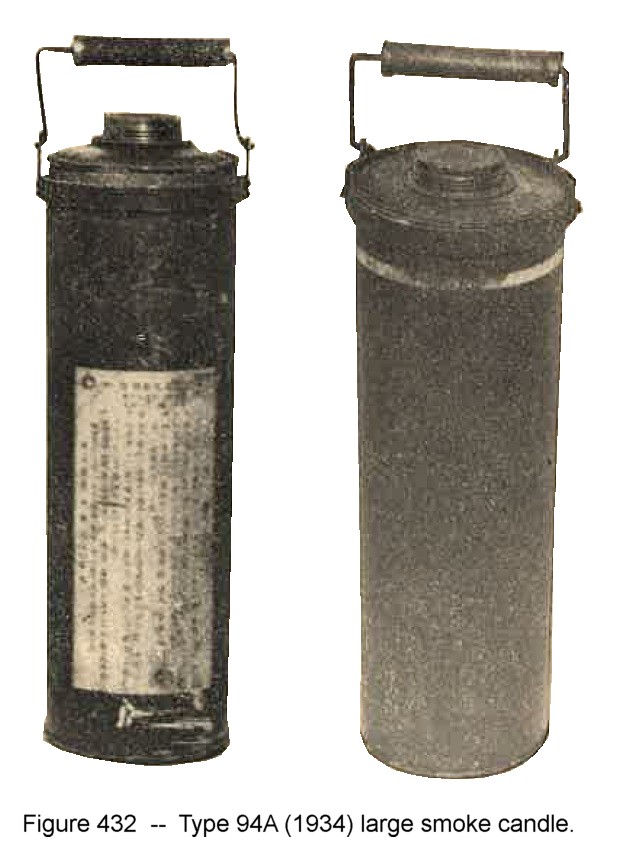 |
 |
 |
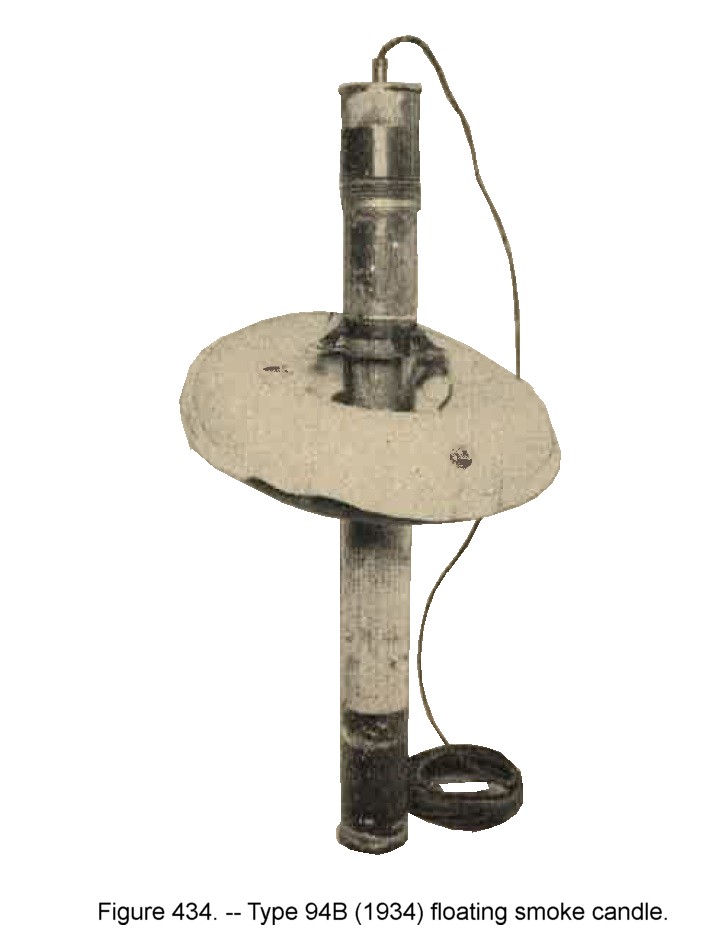 |
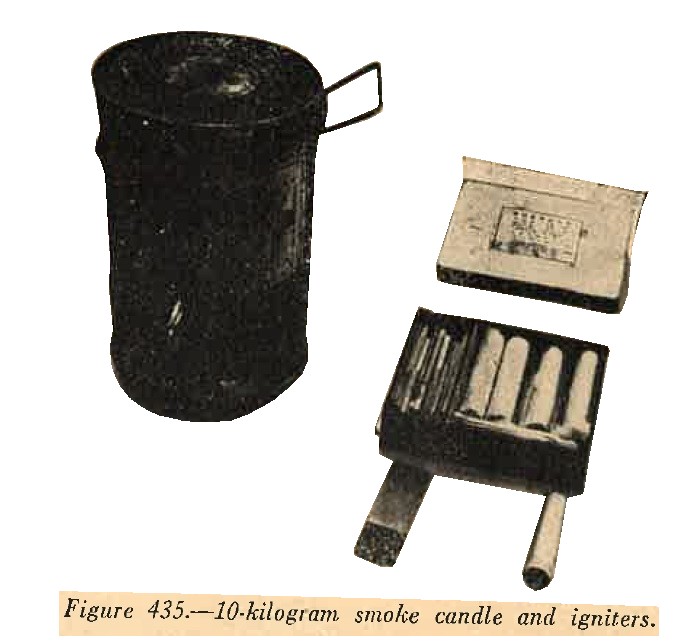 |
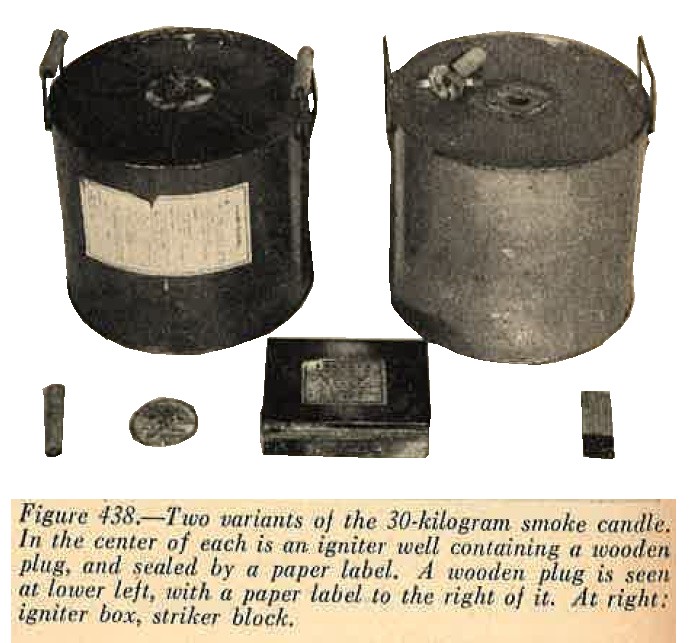 |
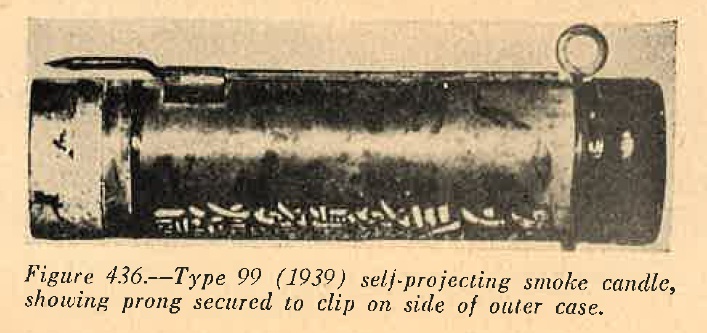 |
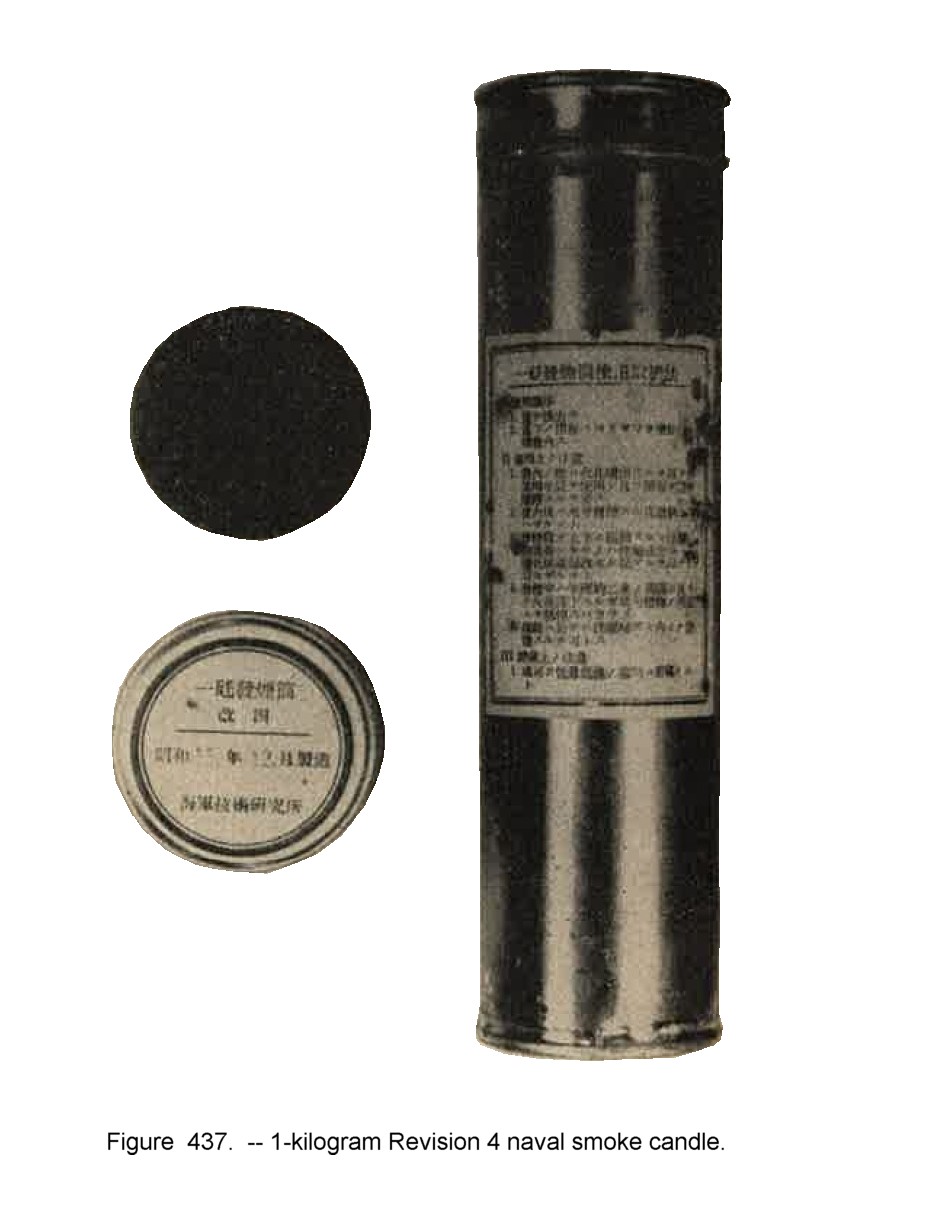 |
10. WWII JAPANESE 40-KILOGRAM (88 POUND) SMOKE GENERATOR, FLOATING
This is a gray welded, steel cylinder, 14 inches high abd 12 inches in diameter, with spray nozzle and ignition system on top. An inflated rubber float can be attached to lugs welded to the casing. The smoke charge consists of 60 pounds of sulfur trioxide chlorosulfonic acid (FS smoke).
